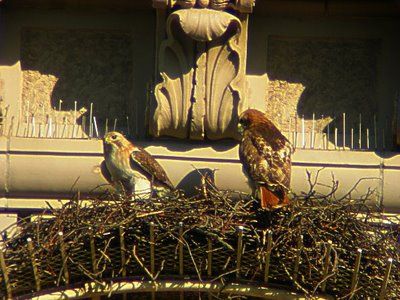
I'm happy to learn that Pale Male, New York City's resident Red-tailed (Buteo jamaicensis) celebrity, is successfully breeding, but the "cute" tone of this New York Times article turns me off. Two months ago, managers at the building on which Pale Male and Lola, his mate, had built their nest tore down some structural supports that the hawks' nest relied on. Activists rallied to have the structure returned, arguing that the hawks would have nowhere to live. This is a well-intentioned, but bogus claim.
Red-tails, like all raptors, are adaptable. While they will return to an ideal location year after year, if that tree should fall (or those supports should be removed), they will find another suitable spot. Most urbanites are too disconnected from Nature's ambivalent perseverance to accept this reality, however, and the building's management reluctantly bowed to popular pressure and returned the supports. Though I’m happy that they did so, it wasn’t entirely necessary.
Today's Times article is exemplary of cute natural history writing; it contributes to our growing ignorance of animal behavior. By projecting our needs onto other species, we confuse our issues with their own. Sometimes this can be helpful in making a popular appeal, but it's just as often problematic.
Also, the article suggests the NYC hawk breeding success story represents a "melding of raw nature with urban life." Urban humanity, despite any defensive assertions to the contrary, is "raw nature." Humans are animals. While I am, in many respects, a Romantic, I detest the Romantic ideal that the forest is pure and the city is corrupt. Though I sometimes do feel that way (and though I long to one day return to a smaller town, away from all this human biomass), environmental sustainability will only come through acceptance of the intimate relationships of the world.
Image credit: ripped from Palemaleirregulars

No comments:
Post a Comment